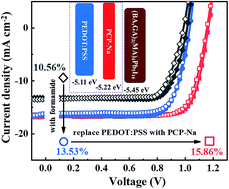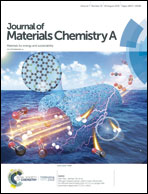Two-dimensional inverted planar perovskite solar cells with efficiency over 15% via solvent and interface engineering†
Abstract
High short-circuit current (Jsc) and open-circuit voltage (Voc) are both required for two-dimensional (2D) perovskite solar cells (PVSCs) with high power conversion efficiency (PCE). In this work, solvent engineering is combined with interface engineering to fabricate 2D PVSCs with enhanced Jsc and Voc. Mixing formamide with N,N-dimethylformamide (DMF) was found to promote the formation of high quality 2D perovskite films with large oriented grains grown through the whole film, because of the high boiling point and polarity of formamide. Poly(3,4-ethylenedioxythiophene):poly(styrenesulfonate) (PEDOT:PSS) was replaced with PCP-Na as the hole transport layer to improve energy level alignment, which suppressed the energy loss at the interface. The optimized inverted planar PVSCs presented an increased Voc of 1.17 V and Jsc of 16.90 mA cm−2, with a maximum PCE of 15.86%, which is one of the highest PCEs for 2D PVSCs. The unsealed device shows excellent moisture stability, which maintained around 93% of its initial efficiency after 1200 hour exposure to air (Hr = 25 ± 5%). This work provides a potential pathway towards high performance 2D PVSCs.



 Please wait while we load your content...
Please wait while we load your content...